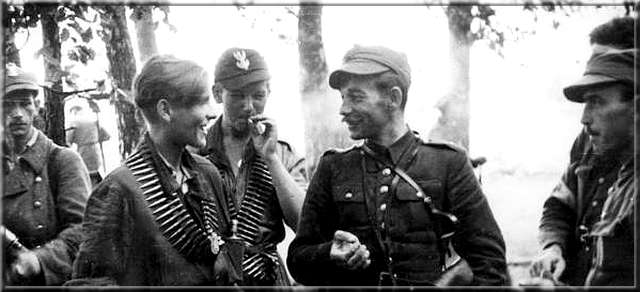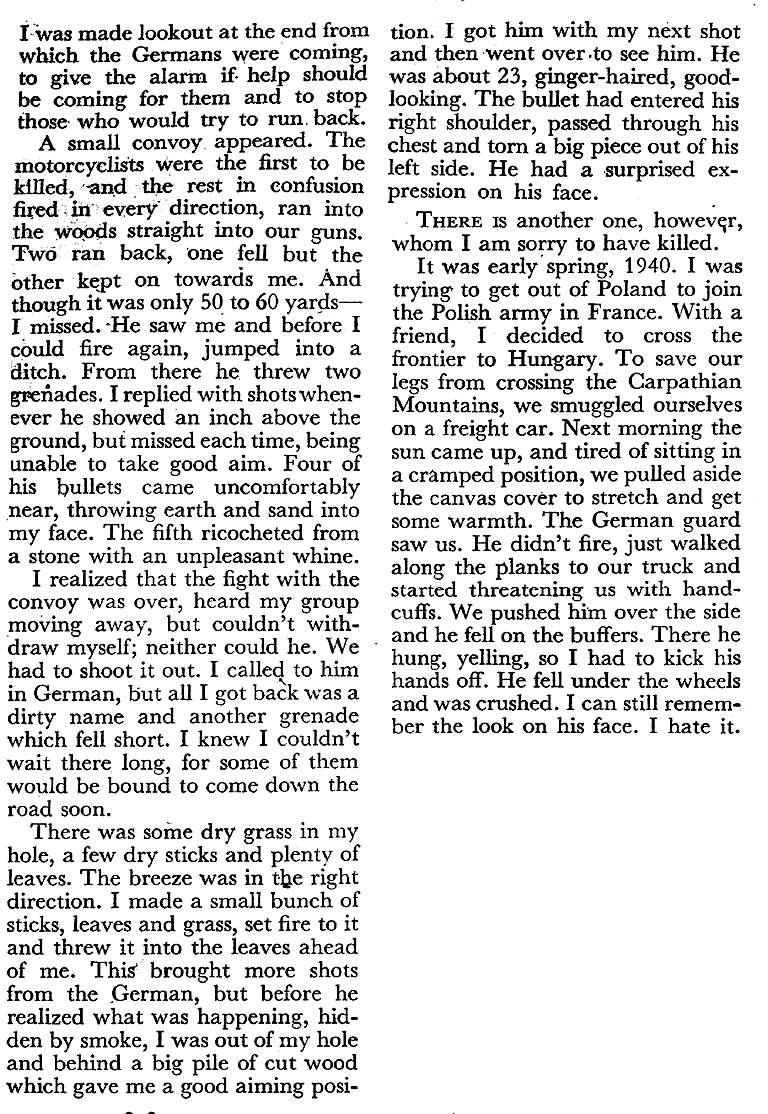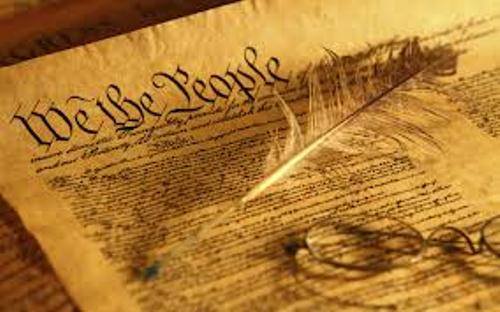The
U.S. Constitution has 4,400 words. It is the oldest and shortest
written Constitution of any major government in the world."
Of
the spelling errors in the Constitution, “Pensylvania” above the
signers’ names is probably the most glaring.
Thomas
Jefferson did not sign the Constitution. He was in France during the
Convention, where he served as the U.S. minister. John Adams was
serving as the U.S. minister to Great Britain during the
Constitutional Convention and did not attend either.
The
Constitution was “penned” by Jacob Shallus, A Pennsylvania
General Assembly clerk, for $30 ($726 today).
Since
1952, the Constitution has been on display in the National Archives
Building in Washington, DC. Currently, all four pages are displayed
behind protective glass framed with titanium. To preserve the
parchment’s quality, the cases contain argon gas and are kept at 67
degrees Fahrenheit with a relative humidity of 40 percent.
Constitution
Day is celebrated on September 17, the anniversary of the day the
framers signed the document.
The
Constitution does not set forth requirements for the right to vote.
As a result, at the outset of the Union, only male property-owners
could vote. African Americans were not considered citizens, and women
were excluded from the electoral process. Native Americans were not
given the right to vote until 1924.
James
Madison, “the father of the Constitution,” was the first to
arrive in Philadelphia for the Constitutional Convention. He arrived
in February, three months before the convention began, bearing the
blueprint for the new Constitution.
Of
the forty-two delegates who attended most of the meetings,
thirty-nine actually signed the Constitution. Edmund Randolph and
George Mason of Virginia and Elbridge Gerry of Massachusetts refused
to sign due in part due to the lack of a bill of rights.
When
it came time for the states to ratify the Constitution, the lack of
any bill of rights was the primary sticking point.
The
Great Compromise saved the Constitutional Convention, and, probably,
the Union. Authored by Connecticut delegate Roger Sherman, it called
for proportional representation in the House, and one representative
per state in the Senate (this was later changed to two.) The
compromise passed 5-to-4, with one state, Massachusetts, “divided.”
Patrick
Henry was elected as a delegate to the Constitutional Convention, but
declined, because he “smelt a rat.”
Because
of his poor health, Benjamin Franklin needed help to sign the
Constitution. As he did so, tears streamed down his face.
Gouverneur
Morris was largely responsible for the “wording” of the
Constitution, although there was a Committee of Style formed in
September 1787.
The
oldest person to sign the Constitution was Benjamin Franklin (81).
The youngest was Jonathan Dayton of New Jersey (26).
When
the Constitution was signed, the United States’ population was 4
million. It is now more than 309 million. Philadelphia was the
nation’s largest city, with 40,000 inhabitants.
A
proclamation by President George Washington and a congressional
resolution established the first national Thanksgiving Day on
November 26, 1789. The reason for the holiday was to give “thanks”
for the new Constitution.
The
first time the formal term “The United States of America” was
used was in the Declaration of Independence.
It
took one hundred days to actually “frame” the Constitution.
There
was initially a question as to how to address the President. The
Senate proposed that he be addressed as “His Highness the President
of the United States of America and Protector of their Liberties.”
Both the House of Representatives and the Senate compromised on the
use of “President of the United States.”
James
Wilson originally proposed the President be chosen by popular vote,
but the delegates agreed (after 60 ballots) on a system known as the
Electoral College. Although there have been 500 proposed amendments
to change it, this “indirect” system of electing the president is
still intact.
George
Washington and James Madison were the only presidents who signed the
Constitution.
In
November of 1788 the Congress of the Confederation adjourned and left
the United States without a central government until April 1789. That
is when the first Congress under the new Constitution convened with
its first quorum.
James
Madison was the only delegate to attend every meeting. He took
detailed notes of the various discussions and debates that took place
during the convention. The journal that he kept during the
Constitutional Convention was kept secret until after he died. It
(along with other papers) was purchased by the government in 1837 at
a price of $30,000 (that would be $629,000 today). The journal was
published in 1840.
Although
Benjamin Franklin’s mind remained active, his body was
deteriorating. He was in constant pain because of gout and having a
stone in his bladder, and he could barely walk. He would enter the
convention hall in a sedan chair carried by four prisoners from the
Walnut Street jail in Philadelphia.
As
Benjamin Franklin left the Pennsylvania State House after the final
meeting of the Constitutional Convention on September 17, 1787, he
was approached by the wife of the mayor of Philadelphia. She was
curious as to what the new government would be. Franklin replied, “A
republic, madam. If you can keep it.”
On
March 24, 1788, a popular election was held in Rhode Island to
determine the ratification status of the new Constitution. The vote
was 237 in favor and 2,945 opposed!
The
members of the first Congress of the United States included 54 who
were delegates to the Constitutional Convention or delegates to the
various state-ratifying conventions. The number also included 7
delegates who opposed ratification.
Benjamin
Franklin died on April 17, 1790, at the age of 84. The 20,000
mourners at his funeral on April 21, 1790, constituted the largest
public gathering up to that time.
Vermont
ratified the Constitution on January 10, 1791, even though it had not
yet become a state.
The
word “democracy” does not appear once in the Constitution.
There
was a proposal at the Constitutional Convention to limit the standing
army for the country to 5,000 men. George Washington sarcastically
agreed with this proposal as long as a stipulation was added that no
invading army could number more than 3,000 troops!
John
Adams referred to the Constitution as “the greatest single effort
of national deliberation that the world has ever seen” and George
Washington wrote to the Marquis de Lafayette that “It (the
Constitution) appears to me, then, little short of a miracle.”
The
Pennsylvania State House (where the Constitutional Convention took
place) was where George Washington was appointed the commander of the
Continental Army in 1775 and where the Declaration of Independence
was signed in 1776. It was also where the Articles of Confederation
were adopted as our first constitution in 1781.
Rhode
Island was the only state not to send delegates to Philadelphia in
1787. At that time the state legislature was controlled by the
agrarian party and was fearful that a stronger central government
would demand that debts be paid in specie (hard money). It was the
last state to ratify the Constitution on May 29, 1790 (over a year
after President George Washington’s inauguration) by a vote of
34-32.
The
delegates were involved in debates from 10 a.m. until 3 p.m. six days
a week with only a 10 day break during the duration of the convention
The
Constitution contains 4,543 words, including the signatures and has
four sheets, 28-3/4 inches by 23-5/8 inches each. It contains 7,591
words including the 27 amendments.
The
Constitution was ratified by specially elected conventions beginning
in December 1787. The order in which the thirteen states accepted the
new constitution was Delaware, Pennsylvania, New Jersey, Georgia,
Connecticut, Massachusetts, Maryland, South Carolina, New Hampshire,
Virginia, New York, North Carolina and Rhode Island.
Daniel
Webster (1782-1852), of Massachusetts, has been called the “Expounder
of the Constitution”.
From
1804 to 1865 there were no amendments added to the Constitution until
the end of the Civil War when the Thirteenth amendment was added that
abolished slavery. This was the longest period in American history in
which there were no changes to our Constitution.
The
text of the Constitution was printed by John Dunlap and David
Claypoole in Philadelphia to then be sent to the various state
constitutional conventions for debate and discussion.
As
evidence of its continued flexibility, the Constitution has only been
changed seventeen times since 1791!
The
main reason for the meeting in Philadelphia was to revise the
Articles of Confederation. However, the delegates soon concluded that
it would be necessary to write an entirely new Constitution. They
agreed to conduct the meetings in secrecy by stationing guards at the
door to the Pennsylvania state house. When one delegate dropped a
convention document, Chairman George Washington replied, “I must
entreat the gentlemen to be more careful, lest our transactions get
into the newspapers and disturb the public repose.”
At
the time of the Constitutional Convention Philadelphia was the most
modern city in America and the largest city in North America. It had
a population of 40,000 people, 7,000 street lamps, 33 churches, 10
newspapers, and a university.
The
median age in America by the end of the 18th century was 16 years of
age (today it is around 34 years of age), 19 of every 20 citizens
lived on the land, and 70% of the land was worked by its owners (30%
by tenants).
The
national government spent $4.3 million during the first session of
Congress from 1789-1791. During the last year that George Washington
was President of the United States (1796-1797), the entire cost of
running the federal government was $5,727,000.
The
election of George Washington as the first President under the
Constitution was not really “unanimous”. In actuality, two
electors from Virginia and two electors from Maryland did not vote.
New York was entitled to eight electoral votes but the state
legislature could not decide how these electors would be chosen, so
the state of New York officially did not vote for the President. The
electoral vote in 1789 should have totaled 81 but only 69 votes were
cast.
James
Madison of Virginia was responsible for proposing the resolution to
create the various Cabinet positions within the Executive Branch of
our government and twelve amendments to the Constitution of which ten
became the Bill of Rights.
Although
the United States Treasury Department stopped distributing currency
denominations of $500, $1,000, $5,000 and $10,000 in 1969, for all
intents and purposes the production of each stopped after World War
II. However, these notes are still legal tender and may be found on
rare occasions in circulation. James Madison, the “Father of the
Constitution” is on the $5,000 bill.
At
the conclusion of the Constitutional Convention, Benjamin Franklin
observed the symbol of a half-sun on George Washington’s chair and
remarked, “I have the happiness to know that it is a rising and not
a setting sun.”
Benjamin
Franklin made a suggestion at the Constitutional Convention that the
sessions be opened with a prayer. The delegates refused to accept the
motion stating that there was not enough money to hire a chaplain.
Of
the fifty-five delegates who attended the convention 34 were lawyers,
8 had signed the Declaration of Independence, and almost half were
Revolutionary War veterans. The remaining members were planters,
educators, ministers, physicians, financiers, judges and merchants.
About a quarter of them were large land owners and all of them held
some type of public office (39 were former Congressmen and 8 were
present or past governors).
William
Few of Georgia was the only member to represent the yeoman farmer
class which comprised the majority of the population of the country.
Nineteen of the members who were chosen to represent their state
never attended a meeting.
Benjamin
Franklin of Pennsylvania was known as the “Sage of the
Constitutional Convention.” He was also the mediator at the
convention and often counseled that “we are here to consult, not to
contend”.
George
Washington and James Madison were the only Presidents who signed the
Constitution.
Elbridge
Gerry of Massachusetts was opposed to the office of vice president.
“The close intimacy that must subsist between the President and
Vice President makes it absolutely improper.” However, he put his
feelings aside and became Vice President under James Madison!
When
Paul Revere learned that Sam Adams and John Hancock were reluctant to
offer their support for the Constitution during the ratification
fight, he organized the Boston mechanics into a powerful force and
worked behind the scenes for the successful approval by the
Massachusetts convention.
The
only other language used in various parts of the Constitution is
Latin.
The
term “others” is used in the Constitution to categorize ethnic
minorities.
Four
of the signers of the Constitution were born in Ireland.
John
Tyler was the first Vice President to assume the responsibilities of
the Presidency upon the death of William Henry Harrison in 1841.
There was nothing in the Constitution that provided for the vice
president to BECOME the president. Article II, Section 6 of the
Constitution states that: “In case of the removal of the President
from office, or of his death, resignation, or inability to discharge
the powers and duties of the said office, the same shall devolve on
the Vice President...” The Article did not state that the vice
president would BECOME the President! Tyler immediately began to
refer to himself as the President with no actual Constitutional
authority to do so, and every succeeding vice president in the same
position did the same. It was not until the Twenty-Fifth Amendment
was passed in 1967 that the vice president technically BECAME the
president. This amendment legitimatized Tyler’s unconstitutional
assumption!
During
an event to celebrate the Constitution’s Sesquicentennial in 1937,
Harry F. Wilhelm recited the entire document through the newly added
21st Amendment from memory. He then obtained a job in the
Sesquicentennial mailroom!















